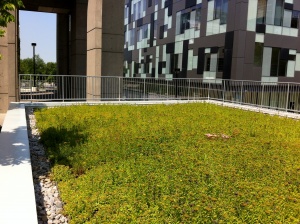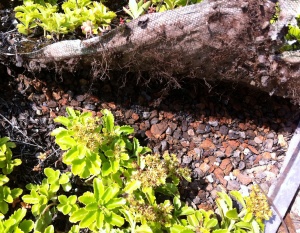Green roofs: Performance
Revision as of 01:50, 9 November 2017 by Jenny Hill (talk | contribs) (Created page with "thumb|Recently laid ''Sedum'' mats on a ground level podium roof. File:YorkU2.jpg|thumb|Detail showing the early root development through the mat to the...")
Green roof performance has not been reported to reduce over time. Controlled studies have instead indicated that maturing green roofs may have improved water retention properties [1].
The key hydrologic benefit which green roofs have over other forms of LID is the proportion of the water returned to the atmosphere through evapotranspiration.
- In Southern Ontario rainwater retention of extensive green roofs without irrigation is between 60% and 70%[2][3][4].
- Including winter periods with snow accumulation and thaw, the annual retention of extensive green roofs is around 50% [5][4].
- Using a compost based planting medium improves retention by around 10% i.e. 60 % for compost compared to 50% for granular.
- Daily irrigation can reduce the annual retention by 20% compared to a roof without irrigation. i.e. 40% for irrigated compared to 60% without irrigation[4]. However, recirculating rainwater from a cistern was estimated to double the annual retention in Florida[6]. The research team modeled 87% retention for a green roof coupled with a cistern, compared to 43% for the green roof alone.
An appropriate NRCS curve numbers for green roofs without irrigation in Southern Ontario is 90 [7][8].
- ↑ http://www.sciencedirect.com/science/article/pii/S0022169417300768
- ↑ http://www.sustainabletechnologies.ca/wp/wp-content/uploads/2013/03/NRC_EastviewGRrept.pdf
- ↑ http://www.sustainabletechnologies.ca/wp/wp-content/uploads/2013/03/GR_york_fullreport.pdf
- ↑ 4.0 4.1 4.2 Hill J, Drake J, Sleep B, Margolis L. Influences of Four Extensive Green Roof Design Variables on Stormwater Hydrology. J Hydrol Eng. 2017;22(8):04017019. doi:10.1061/(ASCE)HE.1943-5584.0001534
- ↑ http://www.sustainabletechnologies.ca/wp/wp-content/uploads/2013/03/GR_york_fullreport.pdf
- ↑ http://www.mdpi.com/2073-4441/4/4/914
- ↑ Curve Number and Runoff Coefficients for Extensive Living Roofs Elizabeth Fassman-Beck, Ph.D., A.M.ASCE; William Hunt, Ph.D., P.E., M.ASCE; Robert Berghage, Ph.D.; Donald Carpenter, Ph.D., P.E., M.ASCE; Timothy Kurtz, P.E., M.ASCE; Virginia Stovin, Ph.D.; and Bridget Wadzuk, Ph.D., A.M.ASCE
- ↑ Hill J, Drake J, Sleep B, Margolis L. Influences of Four Extensive Green Roof Design Variables on Stormwater Hydrology. J Hydrol Eng. 2017;22(8):04017019. doi:10.1061/(ASCE)HE.1943-5584.0001534

